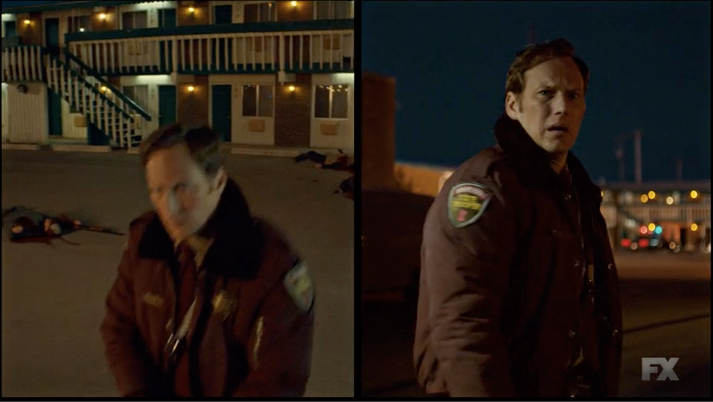I’ve never been inside the Fargo writers’ room, but I imagine it has a vast white wall filled with metaphors, parables, riddles, and urban legends, each one waiting to be plucked by a writer and pasted into one of the show’s comically overwrought scripts. They will all become monologues for one of the series’ Midwestern soothsayers at some point, planted to distract us from the otherwise routine “true crime” stories Fargo has now spun for two seasons.
How else to explain the way the characters on this show speak? Last night’s Season 2 finale had some doozies: cancer-induced fever dreams, regular fever dreams, ruminations on empire-building and the nature of language. By the time a character started to quote Albert Camus on the meaning of life, I felt downright trolled.
This stings because, like almost every episode of Fargo, the finale was filled with gorgeous sequences and genuine payoffs. Consider the final moments with Ed and Peggy Blumquist (Jesse Plemons and Kirsten Dunst), who find themselves cornered in the meat locker of a Sioux Falls grocery store. The hapless couple set this season’s tangled crime plot in motion when Peggy ran over the scion of a local crime family and took him home in her windshield. As has become Fargo’s M.O., their sweet Minnesotan facade gave way to increasingly disturbing behavior, until the pair emerged as the season’s wiliest villains. In the meat freezer, Ed bleeds out from a gunshot wound and decides he and Peggy need to talk: their marriage just isn’t going to work. She won’t ever let them be happy. All it took was murder, kidnapping, and certain death for Ed to realize some hard truths.
Morbid human comedy, a Fargo specialty, has kept the series from unraveling under the weight of its own metaphors and self-referential madness. Even after several digressions and would-be endings in Season 1, the show rode high as a caper with a warped sense of humor. But after this past few episodes, I’d argue that this just isn’t enough. Fargo’s aesthetic tics, once diverting, now feel like more creative hodgepodge. Split screens intrude up and down, left and right, three at a time; exploding gunshots freeze-frame for no particular reason. Setting Season 2 several decades before the first, in 1979, exacerbated the sense the characters are playing a baroque and grim game of dressup: the costumes, the accents, even the mannered gaits often feel like witless caricatures. And then there is that tendency for the characters to summon elaborate backcountry poetry to explain their every whim and motivation, long monologues that feel a lot like lectures.
So I could mention this season’s strange, intertwined mashup of racial and gender empowerment, ending with a ruthless Native American assassin who becomes the season’s stealth hero. Or that “Loplop,” the eighth episode, is one of the most purely entertaining hours of TV this year. Or how touchingly the show handled its cancer subplot (anchored by Cristin Milioti), or Kirsten Dunst’s uneven but bracing performance as a deranged hairdresser. But by the finale, they all feel like pawns in Fargo’s wayward ambitions to be a different, more elevated show.
To understand how far the series’ self-indulgence has gone, look no further than the season’s penultimate episode. During a tense, climactic gunfight between police and the Gerhardt gang, a spaceship that would would have embarrassed The X-Files in 1993 showed up and briefly distracted everyone with flashing light beams. Really. Admirably devoted fans have spun plenty of theories about what the UFO might be, what it might mean. It’s all pointless. Yes, there were hints of strange lights in the sky and alien invaders earlier in the season; sure, the episode’s storybook frame means the narrator could be unreliable. But in the last moments of the finale, the show itself shrugs its shoulders. As the season’s central state trooper, Solverson (Patrick Wilson), discusses the case with his father-in-law, Sheriff Larsson (Ted Danson), they have a telling back and forth:
Larsson: You going to put that in your report, then?
Solverson: What—gun fight interrupted by spacecraft?
Larsson: Yeah … maybe leave that subtext.
How coy. Watching the scene, I once again imagined the writers’ room, wondering if the exchange was a cry for help from a lone dissenting writer staring at the big white metaphor board. Maybe leave that subtext. The series did not, which might have been brave if it didn’t feel like such an utterly manufactured Coenism. And that’s the root of the problem: Fargo has long been full of references to Joel and Ethan Coen’s namesake classic, but at its best, it has also been a living, twanging creature of its own. The Season 2 finale makes it clear that sometimes, the series is content to borrow wholesale from the Coens’ off-kilter universe, without earning a second of it. Fargo the TV series is an ambitious crime show with big, messy ideas about the American dream. It is not a Coen brothers movie. As long as it pretends to be, it will never be a great series in its own right.
